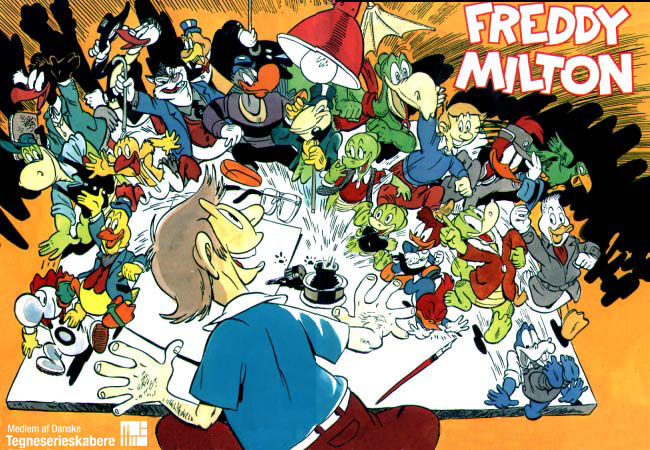Oggi vi propongo un'intervista fatta al cartoonist americano Patrick Blog.
Hi Pat! Do you prefer drawing stories or writing them?
Well, it is all the part of the same process to me. The separating of comics into writing and drawing is strictly an artificial practice, invented by the comic book studios to streamline the process. The artform is a combination of writing and drawing.
Are you self-taught or did you attend any art school?
Edinboro University of Pa. BFA Degree.
By which past Maestro are you inspire the most?
Carl Barks was the artist I devoured the most comics of during my childhood. John Stanley, of Little Lulu fame, was a close second. As an adult, I really enjoy Gray's Orphan Annie, Capp's Lil' Abner, McCay's Nemo, Foster's Prince Valiant, and Goseki's Lone Wolf and Cub.
Which kind of stories do you prefer, I mean humor, thriller, adventure, what else...?
I read quite a lot, and prefer adventure-type tales, science fiction, mysteries, horror, fantasy. As far as writing, I like mystery type tales a lot for the ducks.
What is your process when writing a new story?
Shelly and I work together. Her skills are very character oriented; she is better with gags than me. Generally she comes up with good ten page plots, I am the one who breaks them down into length/format. I'm good with pacing, and she is great with Donald'd personality.
She comes up with the ideas f
Which Disney character do you like most? Why?
I've always enjoyed the nephews the most. I like how they take charge and are capable, more so than Donald or Scrooge at times. I like their three-speaking as one gimmick, the way they stack atop one another, and how cute they look in hats. They are the simplest in design, and in some way very pure cartoons, like the early Mickey.
Not many people know that you also paint. When did you start doing it?
In the sixth grade. I still own a gouache I drew in Mrs. Hamilton's class of the big old house across the street from the school.
I actually minored in painting in college. I've always enjoyed it, and have been painting in watercolors with the Disney characters all along. The oils I've been doing now for the past 8 or so years.
Where do you work?
We work right out of our home in southwestern Pennsylvania. It's a fair sized tudor sort of older home. We have an art school, Art Quest, we run in what used to be our basement. It's Shelly's school, I help out. I teach guitar there, and occasional drawing classes.
Upstairs, I have a studio in one of our bedrooms for my duck stories, and a separate sunroom for oil painting in that is very pretty.
What instruments do you use?
My published stories are drawn with Winsor Newton Series 7 Brushes exclusively on Strathmore Seris 500 Bristol Board, 3 ply. I use FW Acrylic Ink, Yarka St. Petersburg imported watercolors, and ARCHES watercolor paper. I only use the best materials for everything. You only live once, and I try to give everything I do 100% effort.
You started drawing Hazel the Witch. What did you like of her?
My collector friend Ron Fernandez and I broke into Disney comics back in 1993. He was a fan of Hazel, and write the first four stories I drew. Two of these tales use this friendly, confused witch, and I suspect Ron took her much further, and with better characterzation, than the Disney studio ever did in it's short with her.
You also drew the first version of Barks' SOMEWHERE IN NOWHERE. How did it feel ?
The day Carl asked me to draw 'Somewhere in Nowhere', I fell off my art stool, I was so excited. I had met him the previous year at Steve Geppi's place, and he had already read and enjoyed our story, 'Three Little Cupids', and that story convinced him to use me for SIN.
The only better m
No matter how long I work as an artist, I will never hear anything that sounds sweeter than that.
Your last published story, The Case of the Missing Mummy, reminds me a bit of Barks. Is that true to you?
Does it? I've been forced to work somewhat smaller in recent years, than in my earlier stories because of a lack of scanners large enough at the publisher to hold the darn pages. I felt somewhat cramped on this story, but I am always glad to hear any comparison to Carl.
'The Case of the Missing Mummy' was a sort of experiment- an unusual story premise. The entire tale takes place inside the museum, which was a challenge I wanted to set. I was interested in seeing if I could hold interest for a long story like this, for that length of time. It is a detective mystery story, and I wanted it to actually be interesting and 'solvable'. Too often stories of this ilk are illogical or, have no way to solve them before the end.
This was a tough story to pull off, but it was fun and interesting. Hopefully people enjoyed it!
Who do you feel you should thank the most for your career (except your w
My grandmother started me down the road to being a Disney cartoonist. She bought countless "funny books" as she called them, and read them to me at an extremely early age. I still have a couple of coverless issues she bought me when I was only 3 or 4 years old. She read them to me so many times I had them memorized, and could recite them back to her before I could read.
I probably have read some of Carl's stories a hundred times each. There's nothing like infinite familiarity to drive his storytelling style deep into one's subconscience!














